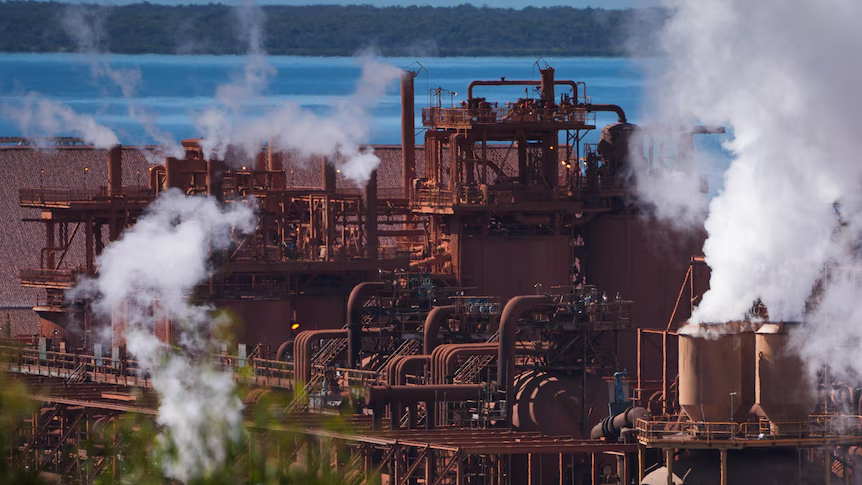Australia’s green hydrogen industry is facing a series of setbacks that threaten its rapid growth. Once hailed as a game-changer for energy and industry, the fuel’s future now appears uncertain. Gladstone, a city long reliant on coal, was expected to transform into a hub for green hydrogen. Local businesses and residents had high hopes that the zero-emission fuel would drive large-scale investment and job creation. Chris Skerman, who runs a civil construction and industrial maintenance company, recalled the excitement. “Very, very big projects were being discussed — billions and billions of dollars worth of construction in the area. It was pretty exciting,” he said.
Some projects did begin, including Fortescue’s $150 million green hydrogen facility on Gladstone’s outskirts, which opened in April 2024. However, just over a year later, the facility remains largely inactive. Fortescue has scaled back its hydrogen ambitions, and other companies have exited the sector entirely. Skerman said the community’s enthusiasm has been replaced by uncertainty. “I don’t think too many people know what the future is for hydrogen at the moment,” he added.
The past year has been challenging for green hydrogen advocates. A $14 billion project backed by the Queensland government-owned Stanwell Corporation was canceled. Origin Energy withdrew from a major Hunter Valley project, citing economic concerns, leaving only its partner, explosives manufacturer Orica, to continue with a scaled-back plan supported by over $430 million in federal funding. Fortescue also ended its Gladstone project and a similar venture in Arizona. While the company remains committed to using hydrogen for green iron production at its Pilbara mine, its ambitious expansions have been paused. Dino Otranto, Fortescue’s metals and operations chief executive, defended the company’s approach, saying risk-taking is part of developing new energy technologies. The federal government awarded Fortescue more than $44 million in funding for the Gladstone plant, which the company intends to repay where possible.
Australia’s “renewable superpower” strategy relies on the country’s abundant solar and wind resources to produce green hydrogen for export and industrial use. Some sectors, like steel and cement, cannot fully decarbonize without switching from gas to hydrogen. Governments have invested heavily, with $4 billion earmarked for production credits that reward hydrogen producers per kilogram of output. Yet analysts argue the industry remains expensive. Saul Kavonic, an energy expert, said green hydrogen currently costs 300 to 700 percent more than natural gas. “To become competitive, the cost of both electricity and electrolyser technology must fall significantly,” Kavonic explained.
Despite these challenges, Energy Minister Chris Bowen maintains confidence in the technology. Bowen compared hydrogen to early solar and battery technologies, noting that both were once too costly to be commercially viable. He emphasized hydrogen’s importance in decarbonizing critical industries. “If you’re serious about climate change, green hydrogen has to continue to be developed. There is simply no alternative for replacing natural gas in sectors like steel and cement,” Bowen said. International support also continues. Germany has committed $660 million to a global hydrogen auction to secure buyers for Australian production. Germany relies on imported hydrogen to meet its own decarbonization goals, making Australia a critical partner in the green hydrogen sector.
Experts now argue that the industry should focus on smaller, incremental projects. Alison Reeve, energy program director at the Grattan Institute, said early proposals were often too large to succeed, requiring infrastructure equivalent to Australia’s entire current energy market. “Intermediate projects make sense. Slow, steady steps are better than attempting gigantic leaps,” Reeve said. She also suggested that government support mechanisms should accept early failures as part of developing a new industry. Local leaders see both challenges and opportunities. Gladstone Mayor Matt Burnett suggested exploring blue hydrogen — using natural gas as a transitional fuel — before fully committing to green hydrogen. Skerman emphasized the economic benefits of green hydrogen investment for his region. “This is the industry town — our economy needs it,” he said.
Australia’s green hydrogen industry faces economic and technical hurdles, but government backing and international partnerships keep the sector alive. While large-scale growth may take longer than expected, experts agree that careful, phased development remains the best path forward.

